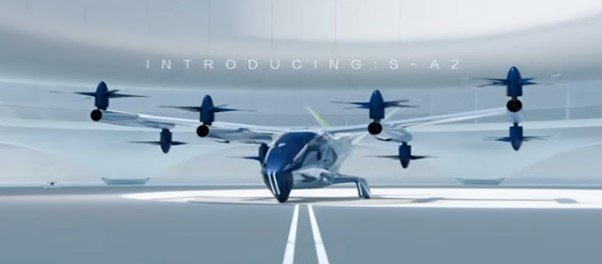As the world grapples with the challenges of worsening traffic congestion and the need for more sustainable transportation solutions, a new era of urban air mobility is on the horizon. At the forefront of this revolution is Hyundai, the global automotive giant, which has unveiled its ambitious plans for an electric vertical take-off and landing (eVTOL) aircraft that could transform the way we move through our cities.
In recent years, many manufacturers have been preparing flying taxis, which may become the next important development direction of travel vehicles. So nowadays, in major exhibitions, you can always see some of these products. Hyundai released a prototype of the SA-1 aircraft , in CES 2020, built with Uber in the pavilion. It has a huge propeller that can seat a total of four passengers, which is quite pompous in terms of styling (at least on the ground).

This year’s CES, Hyundai unveiled a new “flying car” concept called the S-A2. This is a continuation of the S-A1 concept that debuted at CES 2020, and its purpose is roughly the same, which is to carry out short-distance point-to-point transportation within the city, which is the concept of air taxis.
The S-A2 has a cruising speed of about 200km/h and a maximum flight altitude of about 450 meters, and will mainly perform short-range flights of about 40~65km. It has a total of eight propellers propelled by electric motors, and the overall configuration is slightly different from the S-A1. The aircraft can carry one pilot and four passengers, and for safety reasons, there are design redundant power components and flight instruments, which can take over control in the event of a failure of major components.
The S-A2’s design is a testament to Hyundai’s commitment to blending automotive engineering expertise with innovative aerospace technology. The aircraft features a distinctive V-tail configuration and eight tilting rotors that provide the necessary thrust for both vertical take-off and efficient fixed-wing flight. This hybrid approach allows the S-A2 to take off and land vertically, like a helicopter, while transitioning to a more energy-efficient.

One of the key selling points of Hyundai’s eVTOL is its focus on noise reduction. The company claims that the S-A2 will “operate as quietly as a dishwasher,” emitting just 65 decibels during take-off and landing, and an even more subdued 45 decibels while cruising. This is a significant improvement over traditional helicopters, which can generate noise levels of up to 107 decibels, making them a less desirable option for urban environments.
Sustainability is also a core tenet of Hyundai’s air taxi vision. The S-A2 is designed to be fully electric, with the company exploring the use of advanced battery technologies, including lithium-metal and solid-state batteries, to optimize the aircraft’s power-to-weight ratio and range.
By eliminating the need for fossil fuels, Hyundai’s eVTOL promises to deliver a clean and environmentally friendly mode of transportation, aligning with the growing global push for zero-emission mobility solutions.
To ensure the safe and efficient integration of these air taxis into the urban airspace, Hyundai is working closely with regulatory bodies like the Federal Aviation Administration (FAA) and the National Aeronautics and Space Administration (NASA) to establish the necessary frameworks and protocols.
One of the key advantages that Hyundai brings to the table is its extensive experience in mass manufacturing. As a division of the Hyundai Motor Group, Supernal will be able to leverage the company’s highly automated and modular production facilities to scale up the manufacturing of the S-A2 eVTOL.
This could help to drive down the initial costs of these air taxis, making them more accessible to a wider range of consumers.
However, the path to widespread adoption of Hyundai’s flying taxis is not without its challenges. The regulatory approval process for new aircraft designs is notoriously lengthy and complex, with the company needing to obtain three separate certifications from the FAA before it can launch commercial operations.1
Additionally, the initial price point of these eVTOL vehicles may be a barrier for some consumers, at least in the early stages of the market.
Despite these hurdles, Hyundai remains confident in its ability to deliver on its vision for urban air mobility. The company has set an ambitious target of launching its first commercial eVTOL service by 2028, with plans to begin test flights as early as the end of 2024.
This aggressive timeline reflects the company’s belief in the transformative potential of this technology and its commitment to being a driving force in the future of transportation.
This includes the development of advanced air traffic management systems that can coordinate the movements of multiple eVTOL aircraft, as well as the integration of these vehicles into existing aviation infrastructure.
Read More
Hyundai’s Supernal air taxis could take off as early as 2028 | VentureBeat
Written by CHARM-retirement.com
Apr-2024

